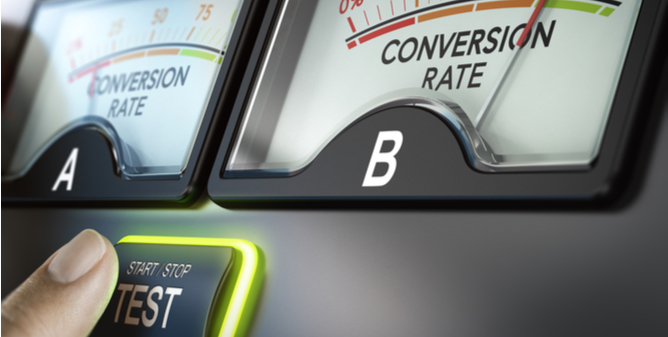 Reading Time: 4 minutes
Reading Time: 4 minutesIt’s easy to measure your business’s efficacy regarding how much your sales team can sell or how many loyal clients you’re able to keep over the years.
However, sales and client numbers only tell part of the story—your sales team can’t continue to sell unless your marketing efforts are successful in bringing additional clients to your door.
Unfortunately, it’s a bit more complicated—and perhaps even a bit misleading—to gauge efficacy solely regarding how many inbound leads you manage to capture.
Thus, the importance of conversion rate. Conversion rate measures just how many of your inbound leads eventually take the leap to become customers. Whether that means making a purchase, signing up for a newsletter, asking for a consultation, or something else depends on your industry, your business model, and multiple other possibilities.
Conversion Rate Optimization
The process of improving your conversion rate—a task referred to as conversion rate optimization, or CRO—begins with improving the way users engage with your brand. However, this is a strategy that extends far beyond developing a beautiful website and even beyond formulating marketing strategies to draw potential clients there. Instead, the crux of CRO rests on improving how users interact with your lead generation site.
Think of it this way—a user is drawn in by your well-placed ad on a website they frequent and click through to your site. Once there, your products, web design, content, or other elements are engaging enough to plant the seed that the user may want to learn more or make a purchase. What they do next depends on your CRO—do they bounce off your page in search of something similar or fill out your lead gen form?
Conduct CRO Testing
If your conversion rate isn’t where you’d like it, you’re losing out on valuable leads and the eventual sales or other potential they bring to the table. However, what you’re missing isn’t always clear from the outset. Instead, most businesses need to perform a series of CRO tests to discover which lead generation site changes really make the difference when it comes to conversions.
For the most part, these tests take the form of simple A/B testing—when you change your lead gen form from configuration A to configuration B, how does the change affect your conversion rate? In this way, you can test one change at a time to isolate—and keep—the changes that work and dismiss those that don’t. Consider this list of simple lead gen site changes to see what works to bump your conversion rates to the next level:
- Shorten your form. Imagine yourself being so interested in a product or service that you click into a lead gen form—only to be confronted with a page that features 15 fillable blanks and requires a good 10 minutes to complete. Chances are, you’d abandon the idea fairly quickly, especially when operating a mobile device. A study by Search Engine Journal found that shorter forms alone resulted in over a 60% increase in leads—crucial evidence you’ll benefit from requesting only the information you need from each user. Reduce forms to 3-5 fillable fields and test conversion response.
- Use action-centered language. It’s known as a “call to action” for a reason. Nothing makes your lead gen form seem like some sort of generic, graded exam than including a “submit” button at the bottom. Switch to positive, active words like “register,” “go,” “request quote,” or even “talk to us,” and even try a more vibrant color scheme for the button. Make one change at a time and test user response to see which is most effective.
- Adjust clarity. Avoid cluttering your lead gen site with extraneous elements and difficult-to-read the text. Your form should have enough open space surrounding it to allow it to breathe and stand out from the rest of your content. Make small changes to improve text readability such as clearer font, larger text, and better color contrast, and prevent other elements from distracting from your form.
- Respond with a human touch. Automatically generated lead responses—while quick—run the risk of sounding impersonal. People want to buy from and communicate with another person. Try responding individually to each lead and include a personal touch and a name within each response. Alternatively, ensure any automatically generated follow-ups include the user’s name and test user response to your human touch.
- Gain user trust. All too often, businesses expect users who are interacting with lead-gen forms to enter distinctly personal information without giving any reassurance regarding how safe the information will be. Make an effort to include symbols of your trustworthiness throughout your webpage, such as the BBB, regulatory agencies, and the like. Then, test efforts to showcase your trustworthiness using such measures as linking your privacy policy directly within your form or including a summary at the bottom.
Analyze Test Results
Implement only one of the above changes at a time, so you can accurately assess the effectiveness of each on your overall CRO efforts. Changes that present an uptick in conversions are changes worth keeping or tweaking further in hopes of improvement. Although the changes listed above commonly lead to conversion rate improvement, if you notice a downtrend, you’ll want to adjust your efforts.
Ready for testing that delves beyond the surface? At Vizion Interactive, our dedicated team has the tools and knowledge of the vital CRO metrics you need to perform analysis of your efforts. We can help you determine which fundamental changes are necessary to drive the conversions you need for success. Reach out today for more information.
Claim Your Free Site Consultation
At Vizion Interactive, we have the expertise, experience, and enthusiasm to get results and keep clients happy! Learn more about how our CRO services can increase sales and boost your ROI. But don’t just take our word for it, check out what our clients have to say, along with our case studies.




